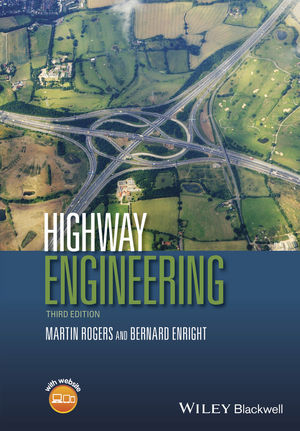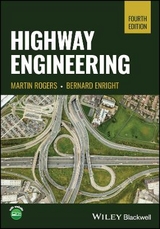
Highway Engineering
Wiley-Blackwell (Verlag)
978-1-118-37815-1 (ISBN)
- Lieferbar
- Versandkostenfrei
- Auch auf Rechnung
- Artikel merken
The repair, renovation and replacement of highway infrastructure, along with the provision of new highways, is a core element of civil engineering, so this book covers basic theory and practice in sufficient depth to provide a solid grounding to students of civil engineering and trainee practitioners.
Moves in a logical sequence from the planning and economic justification for a highway, through the geometric design and traffic analysis of highway links and intersections, to the design and maintenance of both flexible and rigid pavements
Covers geometric alignment of highways, junction and pavement design, structural design and pavement maintenance
Includes detailed discussions of traffic analysis and the economic appraisal of projects
Makes frequent reference to the Department of Transport’s Design Manual for Roads and Bridges
Places the provision of roads and motorways in context by introducing the economic, political, social and administrative dimensions of the subject
Martin Rogers BE, MEngSc, PhD, BA(Public Ad), CEng, MICE, MRTPI, Chartered Engineer and Chartered Town Planner, has worked in private practice as well as in local authorities, and was a member of the Dublin Transport Initiative Study Team that devised the first integrated transportation plan for the Dublin city region. He joined the permanent staff at the Dublin Institute of Technology in 1993, was Assistant Head of School with responsibility for first year engineering from 2010 to 2014, and is currently a Senior Lecturer in the School of Civil and Structural Engineering. Bernard Enright BE, MSc, PhD originally qualified as a civil engineer and worked in information technology in engineering and in the financial markets for 25 years. He joined the School of Civil and Structural Engineering at Dublin Institute of Technology as a Lecturer in Civil Engineering in 2003, where he chairs the Bachelor of Engineering Technology degree programme in Civil Engineering. He completed his PhD on the subject of traffic loading of highway bridges in 2010, and has published extensively on this and related topics.
Preface xii
Sources xiv
1 The Transportation Planning Process 1
1.1 Why are highways so important? 1
1.2 The administration of highway schemes 1
1.3 Sources of funding 2
1.4 Highway planning 3
1.5 The decision making process in highway and transport planning 9
1.6 Summary 14
1.7 References 15
2 Forecasting Future Traffic Flows 16
2.1 Basic principles of traffic demand analysis 16
2.2 Demand modelling 17
2.3 Land use models 19
2.4 Trip generation 20
2.5 Trip distribution 24
2.6 Modal split 35
2.7 Traffic assignment 40
2.8 A full example of the four stage transportation modelling process 46
2.9 Concluding comments 52
2.10 References 52
3 Scheme Appraisal for Highway Projects 53
3.1 Introduction 53
3.2 Economic appraisal of highway schemes 54
3.3 CBA 55
3.4 Payback analysis 68
3.5 Environmental appraisal of highway schemes 70
3.6 The New Approach to Appraisal 76
3.7 NATA Refresh (Department for Transport, 2008) 82
3.8 Summary 83
3.9 References 84
4 Basic Elements of Highway Traffic Analysis 85
4.1 Introduction 85
4.2 Surveying road traffic 85
4.3 Journey speed and travel time surveys 91
4.4 Speed, flow and density of a stream of traffic 96
4.5 Headway distributions in highway traffic flow 103
4.6 Queuing analysis 109
4.7 References 119
5 Determining the Capacity of a Highway 120
5.1 Introduction 120
5.2 The ‘level of service’ approach using Transportation Research Board (1994) 120
5.3 Methodology for analysing the capacity and level of service of highways within Transportation Research Board (2010) 134
5.4 The UK approach for rural roads 159
5.5 The UK approach for urban roads 162
5.6 Expansion of 12 and 16 h traffic counts into AADT flows 165
5.7 Concluding comments 167
5.8 References 168
6 The Design of Highway Intersections 169
6.1 Introduction 169
6.2 Deriving DRFs from baseline traffic figures 170
6.3 Major/minor priority intersections 171
6.4 Roundabout intersections 185
6.5 Basics of traffic signal control: Optimisation and delays 198
6.6 Concluding remarks 218
6.7 References 218
7 Geometric Alignment and Design 220
7.1 Basic physical elements of a highway 220
7.2 Design speed and stopping and overtaking sight distances 222
7.3 Geometric parameters dependent on design speed 231
7.4 Sight distances 232
7.5 Horizontal alignment 236
7.6 Vertical alignment 248
7.7 References 262
8 Highway Pavement Materials and Loading 263
8.1 Introduction 263
8.2 Soils at subformation level 265
8.3 Traffic loading 270
8.4 Materials within flexible pavements 275
8.5 Materials in rigid pavements 282
8.6 References 286
9 Structural Design of Highway Pavements 287
9.1 Introduction 287
9.2 Pavement components: Terminology 288
9.3 Foundation design 290
9.4 Pavement design 301
9.5 References 313
10 Pavement Maintenance 315
10.1 Introduction 315
10.2 Pavement deterioration 316
10.3 Compiling information on the pavement’s condition 317
10.4 Forms of maintenance 328
10.5 References 332
11 The Highway Engineer and the Development Process 334
11.1 Introduction 334
11.2 Transport assessments 335
11.3 Travel plans 341
11.4 Road Safety Audits 346
11.5 References 355
12 Defining Sustainability in Transportation Engineering 357
12.1 Introduction 357
12.2 Social sustainability 357
12.3 Environmental sustainability 357
12.4 Economic sustainability 358
12.5 The four pillars of sustainable transport planning 358
12.6 How will urban areas adapt to the need for increased sustainability? 360
12.7 The role of the street in sustainable transport planning 361
12.8 Public transport 371
12.9 Using performance indicators to ensure a more balanced transport policy 374
12.10 A sustainable parking policy 392
12.11 References 395
Index 397
| Erscheinungsdatum | 28.05.2016 |
|---|---|
| Verlagsort | Hoboken |
| Sprache | englisch |
| Maße | 170 x 244 mm |
| Gewicht | 807 g |
| Themenwelt | Technik ► Bauwesen |
| Technik ► Elektrotechnik / Energietechnik | |
| ISBN-10 | 1-118-37815-6 / 1118378156 |
| ISBN-13 | 978-1-118-37815-1 / 9781118378151 |
| Zustand | Neuware |
| Informationen gemäß Produktsicherheitsverordnung (GPSR) | |
| Haben Sie eine Frage zum Produkt? |
aus dem Bereich



